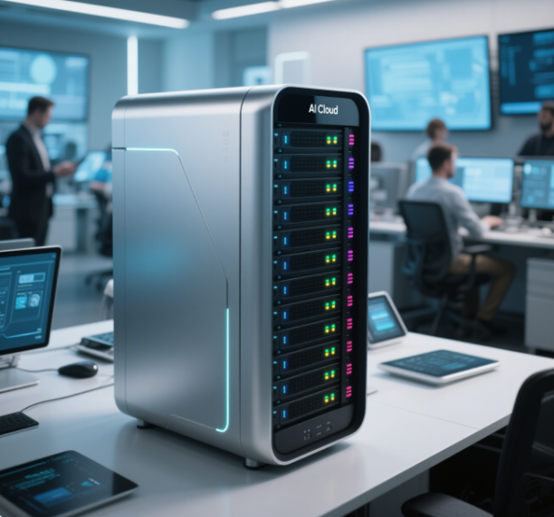AI supercomputing servers differ significantly from traditional servers in hardware architecture, computing power, and application scenarios, which directly affect their technical implementation and business value. Let's explore the more specific differences in the following content!
Hardware architecture design
AI supercomputing servers adopt heterogeneous computing architecture, usually equipped with multiple high-performance GPUs (such as NVIDIA A100/H100) or dedicated AI acceleration chips, and achieve high-speed interconnection through NVLink or InfiniBand to form large-scale parallel computing capabilities. Take PowerLeader PR425KI G2 as an example. The server is equipped with 8 Ascend AI processor modules, supports 32 DDR4 memory slots, and is optimized for deep learning training. Traditional servers mainly rely on general-purpose CPUs (such as Intel Xeon series), adopt homogeneous computing architecture, emphasize instruction-level parallelism rather than data-level parallelism, and have relatively limited memory bandwidth and interconnection capabilities.
Computing performance indicators
AI servers use floating-point computing power (TFLOPS) and AI computing power (TOPS) as core indicators. The Geekbee EVO-T1 desktop AI server is equipped with a Core Ultra 9 285H processor, providing 99 TOPS computing power, and can smoothly run large models such as DeepSeek 32B. The Super Engine Digital Intelligence L20 server supports 10 NVIDIA L20 GPUs and achieves low-latency computing through PCIe Gen5 interconnection. Traditional servers focus more on integer computing performance (IPS) and transaction processing capabilities (TPS), and are suitable for conventional loads such as database queries and Web services.

Memory and storage system
AI servers are equipped with high-bandwidth memory (HBM) and large-capacity video memory. For example, NVIDIA H100 is equipped with 80GB HBM3 video memory and has a bandwidth of 3TB/s. In terms of storage, NVMe SSD arrays are used to support high-speed data throughput to meet the requirements of loading training data sets. Traditional servers usually use DDR4/DDR5 memory and SATA/SAS storage, with a bandwidth of 100-400GB/s, which is suitable for structured data processing.
Network interconnection technology
AI supercomputers rely on RDMA (remote direct memory access) and GPUDirect technology. Huawei's Galaxy AI computing network solution achieves cross-node collaborative training through a 400Gbps lossless network, with a performance loss of less than 2% at a distance of 10KM. Traditional servers use standard Ethernet (10/25/100GbE), and the network latency and throughput are relatively low.
Energy efficiency optimization
AI servers use advanced cooling solutions such as liquid cooling, and the NVIDIA DGX H100 system PUE value can be reduced to 1.15. Traditional servers mostly use air cooling, and the energy efficiency ratio is generally between 1.5-2.0. Energy efficiency differences directly affect the operating costs of data centers. Although AI servers have higher power consumption per unit, they have lower energy consumption per unit computing power.
Software ecosystem support
AI servers are pre-installed with acceleration libraries such as CUDA and ROCm and TensorFlow/PyTorch frameworks, and provide dedicated compilers to optimize model deployment. Traditional servers run general operating systems and middleware, lacking deep optimization for AI tasks.
Differences in application scenarios
AI servers specialize in computing-intensive tasks such as model training (such as large models with tens of billions of parameters), real-time reasoning (autonomous driving decisions), and scientific computing (protein folding). Traditional servers are good at general loads such as transaction processing (ERP systems), content hosting (Web services), and virtualization (VMware clusters).
Procurement and operation and maintenance costs
The cost of a single AI server can reach hundreds of thousands of dollars, requiring maintenance by a professional team. Traditional server prices usually range from thousands to tens of thousands of dollars, and the operation and maintenance threshold is relatively low. However, AI servers can significantly shorten the model training cycle, which may be more advantageous from the perspective of total cost of ownership (TCO).
Reliability requirements
Traditional servers in industries such as finance emphasize 99.999% availability and use redundant designs such as RAID and dual power supplies. AI servers allow short interruptions and use the CheckPoint mechanism to ensure fault tolerance of training tasks.
AI servers are developing towards new technologies such as Chiplet and optical interconnection. SuperEngine L20 already supports PCIe Gen5 and DDR5. Traditional servers focus on cloud native and energy-saving technologies. The future intelligent computing network will achieve an upgrade from "data interconnection" to "computing interconnection". The two architectures will coexist for a long time, and the best solution will be selected based on business needs.



 CN
CN
 EN
EN










